Fixed-Wing UAV Flight Operation under Harsh Weather Conditions: A Case Study in Livingston Island Glaciers, Antarctica
Abstract
1. Introduction
2. Study Site
3. Materials and Methods
3.1. Preliminary Considerations: Choice of the Drone
3.2. Working Hypotheses
- Stability of the aircraft in flight under gusty winds: Setting the stability hypothesis was based on the technical characteristics of the aircraft, stating that the aircraft could withstand lateral winds of up to 50 km/h and gusty winds of up to 15 km/h with a cruise speed of 80 km/h [42]. Therefore, the initial hypothesis was that it could fly with winds less than 50 km/h, and its alternative hypothesis that it could not withstand winds greater than or equal to 50 km/h.
- Battery life: There are previously published studies regarding the decrease in battery life under low temperatures [43]. Therefore, it was anticipated that this effect would occur when flying the RPAS in Antarctica. The unknown to be resolved was the magnitude of this decrease, so the initial hypothesis was set as follows: battery life decreases less than 30%; and its alternative as follows: battery life decreases more than 30%. If the second hypothesis was confirmed, it would not be possible to fly safely, since a minimum reserve of 15% is required.
- Behavior of the drone materials: The behavior of the materials comprising our UAS at low temperatures was unknown, not even the technical specifications made reference to it. The main materials were high-density polyethylene foam and carbon fiber frame structure and composite elements. Accessory elements, such as the shuttle, also had to be taken into account. The initial hypothesis was that none of these materials would be severely affected, and its alternative hypothesis that some of them could fail.
- Metric camera configuration: There are various studies on the reflectance of snow and how it affects photographs, including aerial ones [44]. A study was needed on how to reduce such undesirable effects to obtain images of sufficient quality to produce a solution after image correlation. We started from the hypothesis that good results would be obtained with the adjustments proposed by the manufacturer. If this hypothesis were not corroborated, a manual configuration would be used.
- Aircraft’s ability to fly very long distances: There were some unexplored areas that had not yet been surveyed in previous field campaigns (U1, U2, and U3 in Figure 1). Problems faced here were how to access safely these areas with the available logistics, and estimating a priori the distance that the plane could fly over them. The initial hypothesis raised was based on the drone’s technical characteristics. These indicated that, assuming good battery conditions, the aircraft could travel 60 km in 50 min, reserving 5 min for takeoff and another 5 min for landing. The possibility of varying the flight height to fly over the largest possible surface, with the required precision, was also considered.
3.3. Software Tools
3.4. Flight Operations
3.5. Data Processing
3.6. Modeling the Glacier Surface
3.7. Web Publication and Prototype of Antarctic Space Data Infrastructure (SDI)
4. Results
- As already explained in Section 3.1, the main impediment to flight operations was the wind, together with precipitation. Wind remained constant at typical speeds of 10–15 km/h, reaching peaks of up to 65–100 km/h on some days. An example can be seen in [60]. This limited the actual number of days of flight to 7 out of 20 possible days (gray columns in Table 6).
- 2.
- As mentioned in the Materials and Methods section, in general, the materials of the drone (main materials were high-density polyethylene foam, carbon frame structure and composite elements) were not affected by the low temperatures. This plane lands on its belly, so the structure is sufficiently reinforced to not suffer from landings, although there were some mishaps with bad landings that caused damage to the fuselage (see an illustration in [62]). This landing procedure applies except in the case of the shuttle (Figure 9). As was verified in Flight 4, when temperatures drop below 0 °C, the tension of the launcher tires decreases, which prevents the plane from taking off with sufficient speed. When launching the aircraft with its payload, the elastic band pushes the launch dock with more than 4g and with a speed of more than 60 km/h. As mentioned earlier, to maintain this performance below 0 °C it is necessary to increase by at least 25% the standard elastic tension. To avoid this problem, the manufacturer recommends keeping the launcher as warm as possible and covering it immediately after the plane has been launched. An illustration of the tension of the shuttle tires at takeoff can be seen in [63].
- 3.
- Another problem due to the low temperatures at flight height was the icing of the aircraft wings. This mattered when flying in fog, as in the second flight of the first day. The mist of ice crystals in the fog suddenly lowered while the plane was in flight, causing the aircraft to fall. It was observed that the fuselage was frozen (e.g., Figure 10). The record of the black box was sent to the manufacturer to establish the reasons for the fall and they returned a report indicating that the plane suffered this sudden fall due to the freezing of the Pitot tube because of the low temperatures during the flight. The nearby fog on the first day of operation (Flight 1) can be appreciated in the video [64].
- 4.
- The reflectivity of the snow was another variable that greatly conditioned the results obtained, due to its effects on the quality of the images taken. To reduce this problem, the camera settings had to be modified each day according to the existing lighting, as explained in the methods section. Even with these camera adjustments, when the data were processed, the point clouds obtained had many spikes due to the noise produced by snow reflectivity (Figure 11a). These were eliminated by applying filtering algorithms and point cloud classification to improve the results (Figure 11b).
- 5.
- Regarding the aircraft’s ability to reach remote areas, calculations were made to determine the area that could be covered by the flight and a safe position for the pilot to launch the drone. As shown in previous tables, and taking into account the battery reserve that had to be made to account for cold conditions, the entire planned remote area U3 (Figure 1), extending about 3 km2, could have been covered using a flight height of 300 m. However, when the test flight was carried out, a loss of communication signal happened, which caused the UAS to make an emergency landing during flight F13 (Figure 8).
5. Discussion
Author Contributions
Funding
Data Availability Statement
Acknowledgments
Conflicts of Interest
References
- Quincey, D.J.; Bishop, M.P.; Kääb, A.; Berthier, E.; Flach, B.; Bolch, T.; Buchroithner, M.; Kamp, U.; Khalsa, S.J.S.; Toutin, T.; et al. Digital terrain modeling and glacier topographic characterization. In Global Land Ice Measurements from Space; Kargel, J.S., Ed.; Springer: Berlin/Heidelberg, Germany, 2014. [Google Scholar] [CrossRef]
- Hodson, A.; Anesio, A.M.; Ng, F.; Watson, R.; Quirk, J.; Irvine-Fynn, T.; Dye, A.; Clark, C.; McCloy, P.; Kohler, J.; et al. Respires: Quantifying the distribution and respiration CO2 flux of cryoconite across an entire Arctic supraglacial ecosystem. J. Geophys. Res. -Biogeosciences 2007, 112, wos000252014100001. [Google Scholar] [CrossRef]
- Immerzeel, W.W.; Kraaijenbrink, P.D.A.; Shea, J.M.; Shrestha, A.B.; Pellicciotti, F.; Bierkens, M.F.P.; De Jong, S.M. High-resolution monitoring of Himalayan glacier dynamics using unmanned aerial vehicles. Remote Sens. Environ. 2014, 150, 93–103. [Google Scholar] [CrossRef]
- Steiner, J.F.; Pellicciotti, F.; Buri, P.; Miles, E.S.; Immerzeel, W.W.; Reid, T.D. Modelling ice-cliff backwasting on a debris-covered glacier in the Nepalese Himalaya. J. Glaciol. 2015, 61, 889–907. [Google Scholar] [CrossRef]
- Thakuri, S.; Khadka, D. Potentials and applications of unmanned aerial vehicles in environmental studies in Nepal: A review. J. Nepal Sci. Olympiad. 2016, 1, 31–40. [Google Scholar]
- Fugazza, D.; Senese, A.; Azzoni, R.S.; Smiraglia, C.; Cernuschi, M.; Severi, D.; Diolaiuti, G.A. High-resolution mapping of glacier surface features. The UAV survey of the Forni Glacier (Stelvio National Park, Italy). Geogr. Fis. E Din. Quat. 2015, 38, 25–33. [Google Scholar] [CrossRef]
- Turner, D.; Lucieer, A.; Watson, C. An Automated Technique for Generating Georectified Mosaics from Ultra-High Resolution Unmanned Aerial Vehicle (UAV) Imagery, Based on Structure from Motion (SfM) Point Clouds. Remote. Sens. 2012, 4, 1392–1410. [Google Scholar] [CrossRef]
- Crocker, R.I.; Maslanik, J.A.; Adler, J.J.; Palo, S.E.; Herzfeld, U.C.; Emery, W.J. A Sensor Package for Ice Surface Observations Using Small Unmanned Aircraft Systems. IEEE Trans. Geosci. Remote Sens. 2011, 50, 1033–1047. [Google Scholar] [CrossRef]
- Funaki, M.; Hirasawa, N.; Ant-Plane Group. Outline of a small unmanned aerial vehicle (Ant-Plane) designed for Antarctic research. Polar Sci. 2008, 2, 129–142. [Google Scholar] [CrossRef]
- Funaki, M.; Higashino, S.-I.; Sakanaka, S.; Iwata, N.; Nakamura, N.; Hirasawa, N.; Obara, N.; Kuwabara, M. Small unmanned aerial vehicles for aeromagnetic surveys and their flights in the South Shetland Islands. Antarctica. Polar Sci. 2014, 8, 342–356. [Google Scholar] [CrossRef]
- Turner, D.; Lucieer, A.; Malenovský, Z.; King, D.H.; Robinson, S.A. Spatial Co-Registration of Ultra-High Resolution Visible, Multispectral and Thermal Images Acquired with a Micro-UAV over Antarctic Moss Beds. Remote. Sens. 2014, 6, 4003–4024. [Google Scholar] [CrossRef]
- Gardner, S.; LeRoi, D.; Perryman, W. A penguin population polar express: NOAA’s quest to count penguin breeds speeds up with a VTOL UAS. Unmanned Syst. 2011, 29, 30–35. [Google Scholar]
- Lan, C.-T.E.; Keshmiri, S.; Hale, R. Fuzzy-Logic Modeling of a Rolling Unmanned Vehicle in Antarctica Wind Shear. J. Guid. Control. Dyn. 2012, 35, 1538–1547. [Google Scholar] [CrossRef]
- Van den Kroonenberg, A.; Martin, T.; Buschmann, M.; Bange, J.; Vörsmann, P. Measuring the wind vector using the autonomous mini aerial vehicle M2AV. J. Atmos. Oceanic Technol. 2008, 25, 1969–1982. [Google Scholar] [CrossRef]
- Wójcik-Długoborska, K.A.; Bialik, R.J. The Influence of Shadow Effects on the Spectral Characteristics of Glacial Meltwater. Remote. Sens. 2021, 13, 36. [Google Scholar] [CrossRef]
- Pina, P.; Vieira, G. UAVs for Science in Antarctica. Remote Sens. 2022, 14, 1610. [Google Scholar] [CrossRef]
- AMcKinnis, J.; LaGue, H.; Benyamen; Keshmiri, S. Dynamic Modeling and Flight Test Validation of an In-House Design UAS Built for Polar Research. In Proceedings of the 2020 IEEE Aerospace Conference, Big Sky, MT, USA, 7–14 March 2020; pp. 1–7. [Google Scholar] [CrossRef]
- Rodzewicz, M.; Goraj, Z.; Tomaszewski, A. Design and testing of three tailless unmanned aerial vehicle configurations built for surveillance in Antarctic environment. Proc. Inst. Mech. Eng. Part G J. Aerosp. Eng. 2018, 232, 2598–2614. [Google Scholar] [CrossRef]
- Sheridan, I. Drones and global navigation satellite systems: Current evidence from polar scientists. R. Soc. Open Sci. 2020, 7, 191494. [Google Scholar] [CrossRef] [PubMed]
- Bollard, B.; Doshi, A.; Gilbert, N.; Poirot, C.; Gillman, L. Drone Technology for Monitoring Protected Areas in Remote and Fragile Environments. Drones 2022, 6, 42. [Google Scholar] [CrossRef]
- Li, T.; Zhang, B.; Xiao, W.; Cheng, X.; Li, Z.; Zhao, J. UAV-Based Photogrammetry and LiDAR for the Characterization of Ice Morphology Evolution. IEEE J. Sel. Top. Appl. Earth Obs. Remote Sens. 2020, 13, 4188–4199. [Google Scholar] [CrossRef]
- Váczi, P.; Barták, M. Multispectral aerial monitoring of a patchy vegetation oasis composed of different vegetation classes. UAV-based study exploiting spectral reflectance indices. Czech Polar Rep. 2022, 12, 131–142. [Google Scholar] [CrossRef]
- Malenovský, Z.; Lucieer, A.; King, D.H.; Turnbull, J.D.; Robinson, S.A. Unmanned aircraft system advances health mapping of fragile polar vegetation. Methods Ecol. Evol. 2017, 8, 1842–1857. [Google Scholar] [CrossRef]
- Turner, D.; Lucieer, A.; Malenovský, Z.; King, D.; Robinson, S.A. Assessment of Antarctic moss health from multi-sensor UAS imagery with Random Forest Modelling. Int. J. Appl. Earth Obs. 2018, 68, 168–179. [Google Scholar] [CrossRef]
- Shah, K.; Ballard, G.; Schmidt, A.; Schwager, M. Multidrone aerial surveys of penguin colonies in Antarctica. Sci. Robot. 2020, 5, eabc3000. [Google Scholar] [CrossRef]
- Tan, A.E.-C.; McCulloch, J.; Rack, W.; Platt, I.; Woodhead, I. Radar Measurements of Snow Depth Over Sea Ice on an Unmanned Aerial Vehicle. IEEE Trans. Geosci. Remote Sens. 2020, 59, 1868–1875. [Google Scholar] [CrossRef]
- Liu, E.J.; Wood, K.; Aiuppa, A.; Giudice, G.; Bitteto, M.; Fischer, T.P.; Kilbride, B.T.M.; Plank, T.; Hart, T. Volcanic activity and gas emissions along the South Sandwich Arc. Bull. Volcanol. 2021, 83, 3. [Google Scholar] [CrossRef]
- Fudala, K.; Bialik, R.J. The use of drone-based aerial photogrammetry in population monitoring of Southern Giant Petrels in ASMA 1, King George Island, maritime Antarctica. Glob. Ecol. Conserv. 2021, 33, e01990. [Google Scholar] [CrossRef]
- Hinke, J.T.; Giuseffi, L.M.; Hermanson, V.R.; Woodman, S.M.; Krause, D.J. Evaluating Thermal and Color Sensors for Automating Detection of Penguins and Pinnipeds in Images Collected with an Unoccupied Aerial System. Drones 2022, 6, 255. [Google Scholar] [CrossRef]
- Zmarz, A.; Rodzewicz, M.; Dąbski, M.; Karsznia, I.; Korczak-Abshire, M.; Chwedorzewska, K. Application of UAV BVLOS remote sensing data for multi-faceted analysis of Antarctic ecosystem. Remote Sens. Environ. 2018, 217, 375–388. [Google Scholar] [CrossRef]
- Kung, O.; Strecha, C.; Beyeler, A.; Zufferey, J.C.; Floreano, D.; Fua, P.; Gervaix, F. The Accuracy of Automatic Photogrammetric Techniques on Ultra-Light Uav Imagery. In Proceedings of the UAV-g 2011—Unmanned Aerial Vehicle in Geomatics, Zürich, Switzerland, 14–16 September 2011. [Google Scholar]
- Open Geospatial Consortium (OGC). Available online: https://www.ogc.org (accessed on 12 March 2022).
- Infraestructura de Datos Espaciales Española (IDEE). Available online: http://www.idee.es (accessed on 12 March 2022).
- Directiva Europea INSPIRE. Available online: https://inspire.ec.europa.eu (accessed on 12 March 2022).
- Organización Internacional de Estandarización. Available online: https://www.iso.org/home.html (accessed on 12 March 2022).
- Bañón, M.; Vasallo, F. AEMET en la Antártida. Climatología y Meteorología Sinóptica en la Estaciones Meteorológicas Españolas en la Antártida; AEMET: Madrid, Spain, 2015. [Google Scholar]
- Brezoescu, A.; Castillo, P.; Lozano, R. Straight-Line Path Following in Windy Conditions. ISPRS–Int. Arch. Photogramm. Remote Sens. Spat. Inf. Sci. 2012, XXXVIII-1, 283–288. [Google Scholar] [CrossRef]
- Watts, A.C. Ambrosia, Vincent G. Hinkley, Everett A. Unmanned Aircraft Systems in Remote Sensing and Scientific Research: Classification and Considerations of Use. Remote Sens. 2012, 4, 2072–4292. [Google Scholar] [CrossRef]
- Barton, J.D. Fundamentals of Small Unmanned Aircraft Flight. Johns Hopkins APL Tech. Dig. 2012, 21, 132–149. [Google Scholar]
- Trimble UAV UX5. Available online: https://geotronics.es/productos/aeronaves-no-tripuladas/trimble-ux5 (accessed on 12 March 2022).
- Camera Sony NEX-5. Available online: https://www.sony.es/electronics/support/res/manuals/4437/44370084M.pdf (accessed on 12 March 2022).
- Trimble UX5 User Guide. Available online: https://help.trimblegeospatial.com/TALegacy/Help%20Files/AI_2_0/Espanol/UX5AerialImagingUserGuide.pdf (accessed on 12 March 2022).
- Torno, C.; Hintz, C.; Carrillo, L.R.G. Design and Development of a Semi-Autonomous Fixed-Wing Aircraft with Real-Time Video Feed. In Proceedings of the International Conference on Unmanned Aircraft Systems (ICUAS), Orlando, FL, USA, 27–30 May 2014; pp. 1021–1028. [Google Scholar] [CrossRef]
- Dumont, M.; Arnaud, Y.; Six, D.; Corripio, J.G. Retrieval of glacier surface albedo using terrestrial photography. Houille Blanche-Rev. Int. De L Eau. 2009, 2, 102–108. [Google Scholar] [CrossRef]
- Trimble Access Aerial Imaging. Available online: https://apps.trimbleaccess.com/help/en/AerialImaging=2.2.6 (accessed on 12 March 2022).
- Trimble. Available online: https://www.trimble.com (accessed on 12 March 2022).
- Trimble Business Center (TBC). Photogrammetry Module. White Paper. 2013. Available online: https://www.cansel.ca/store/_ui/responsive/theme-cansel/pdf/canselContent/Trimble-Business-Center-Photogrammetry-Module-White-Paper-English.pdf (accessed on 12 March 2022).
- ESRI España. Available online: https://www.esri.es/es-es/arcgis/sobre-arcgis/introduccion (accessed on 12 March 2022).
- PostGIS Spatial and Geographic Objects for PostgreSQL. Available online: https://postgis.net (accessed on 12 March 2022).
- GeoServer. Available online: http://geoserver.org (accessed on 12 March 2022).
- Youtube Video (by the Authors). Available online: https://youtu.be/Ymxtm6uv_Ec (accessed on 3 November 2022).
- López-Cuervo Medina, S. Apuntes de Fotogrametría Digital; Universidad Politécnica de Madrid, Fotogrametría: Madrid, Spain, 1980; ISBN 84-3000-2559-6. [Google Scholar]
- Software GRASS. Available online: https://grass.osgeo.org (accessed on 12 March 2022).
- Cerro, G. Estudio y Comparativa de Algoritmos de Modelado 3D en Software Libre y Propietario para el Desarrollo de un Prototipo de una IDE de la Antártida. Master Thesis, Universidad Politécnica de Madrid, Madrid, Spain, 2020. [Google Scholar]
- Cloud Optimized GeoTIF. Available online: https://www.cogeo.org/ (accessed on 12 March 2022).
- Sierra, A. GeoJSON y TopoJSON: Comparación Entre los Formatos de Intercambio de Información Geográfica Alternativos a GML. In Proceedings of the IV Jornadas Ibéricas de Infraestructura de Datos Espaciales, Toledo, Spain, 13–15 November 2013. [Google Scholar]
- 13LandXML. Available online: https://www.landxml.org (accessed on 12 March 2022).
- Sterling, J. The History and Importance of Web Mapping; College of Earth and Mineral Sciences, The Pennsylvania State University: State College, PA, USA, 2017. [Google Scholar]
- OpenLayers. Available online: https://openlayers.org (accessed on 12 March 2022).
- Youtube Video (by the Authors). Available online: https://youtu.be/9vMfRgaEy48 (accessed on 3 November 2022).
- YouTube Video (Noticas Cuatro, 21/12/2014). Available online: https://youtu.be/SGOq3JtO1C8 (accessed on 3 November 2022).
- Youtube Video (by the Authors). Available online: https://youtu.be/Bg3YP6harDk (accessed on 3 November 2022).
- Youtube Video (by the Authors). Available online: https://youtu.be/GEdMn_JegI8 (accessed on 3 November 2022).
- Youtube Video (by the Authors). Available online: https://youtube.com/watch?v=Jy0ugcvqgik&feature=share (accessed on 3 November 2022).
- NASA. Available online: https://spinoff.nasa.gov/Spinoff2011/ps_2.html (accessed on 12 March 2022).
- Centro Geográfico del Ejército de Tierra Español (CGET). Available online: https://ejercito.defensa.gob.es/unidades/Madrid/ceget (accessed on 12 March 2022).
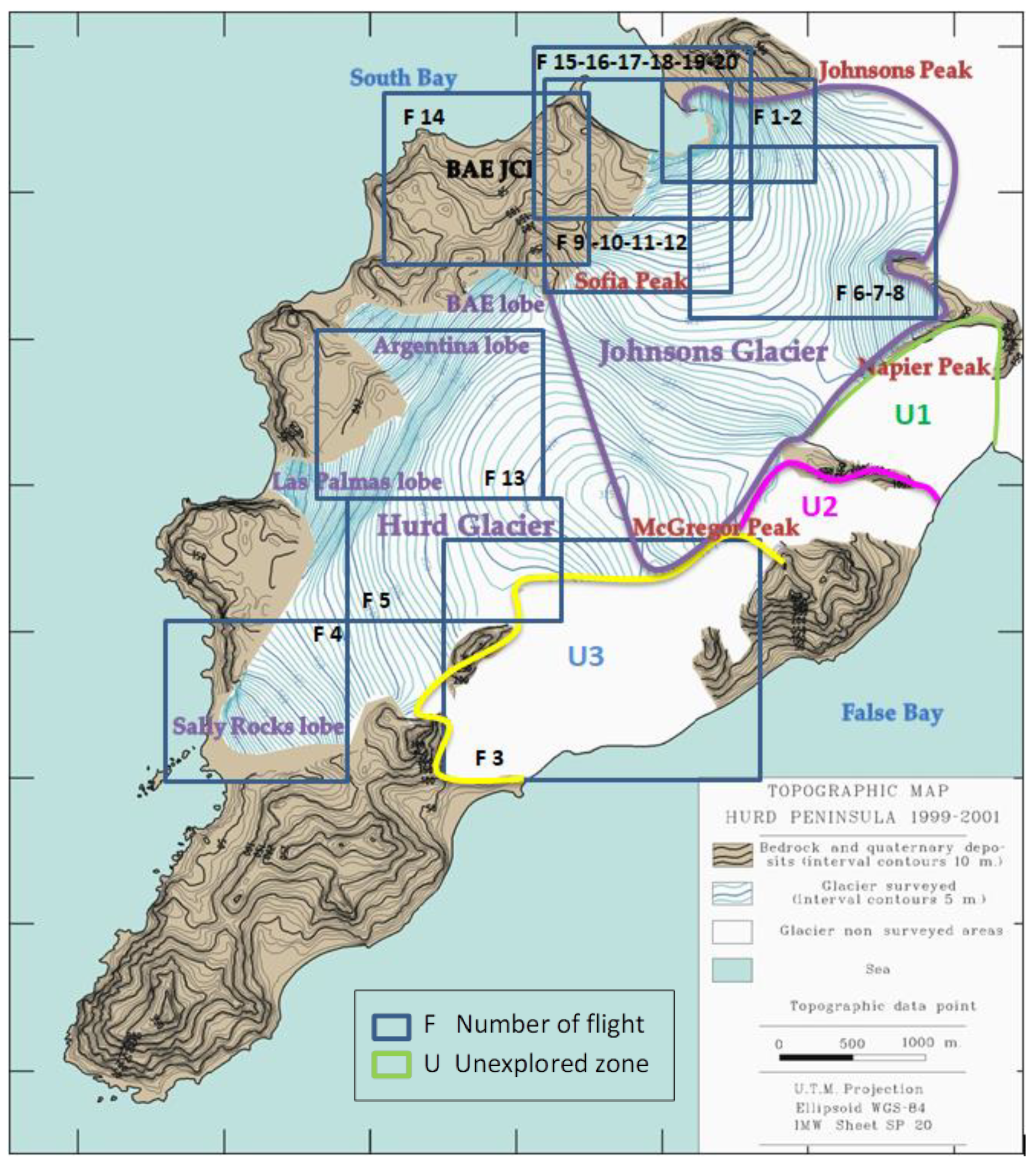

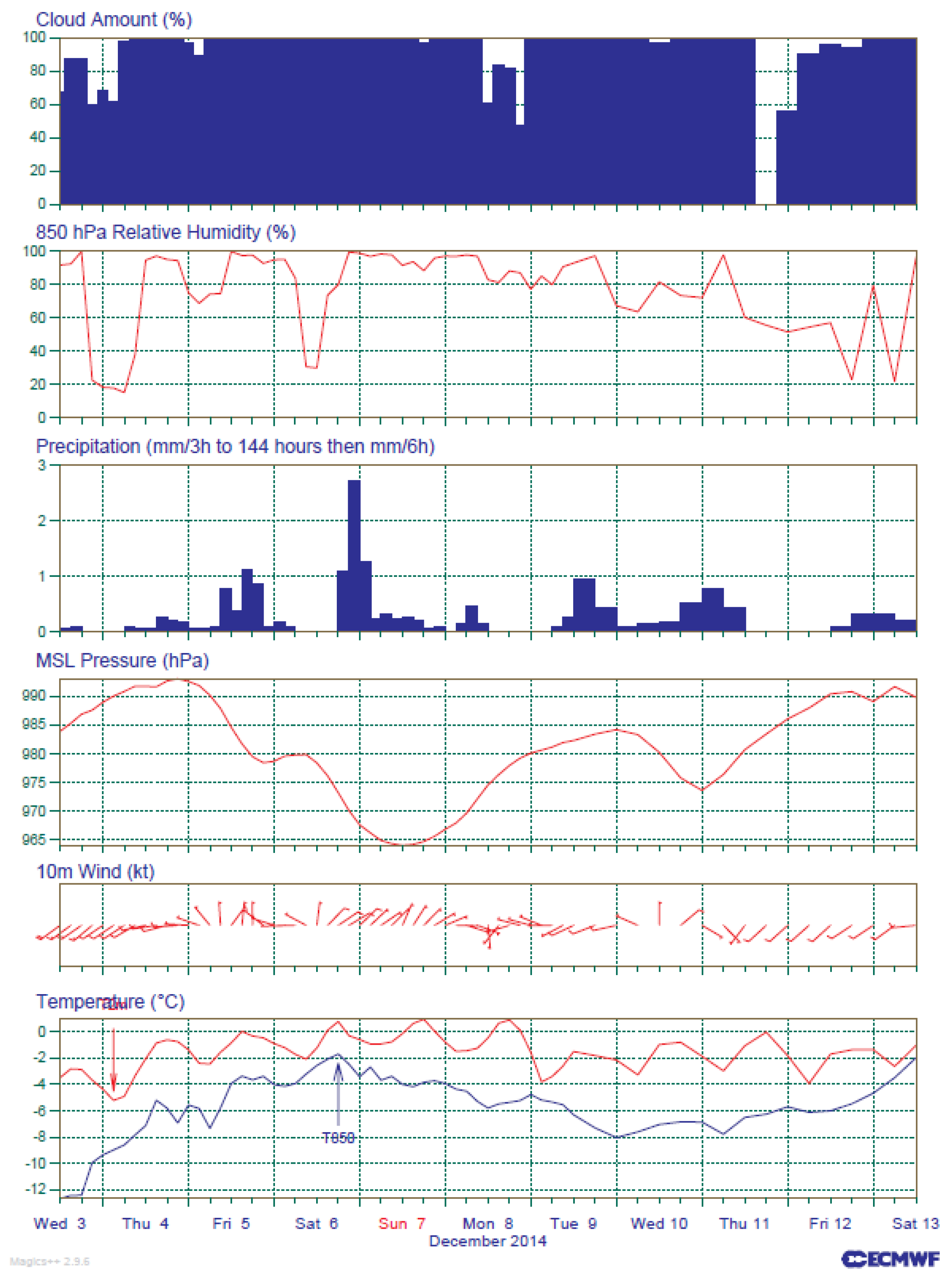

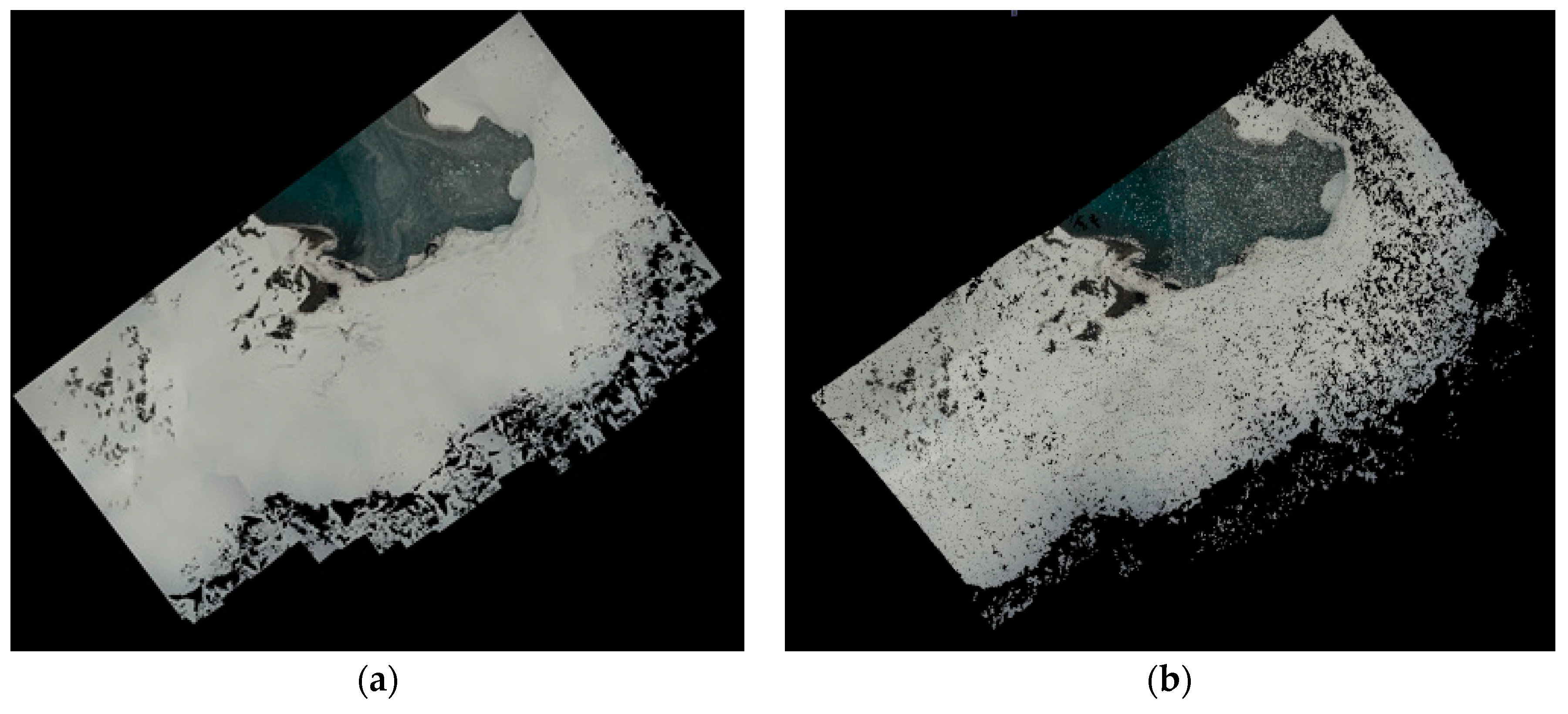

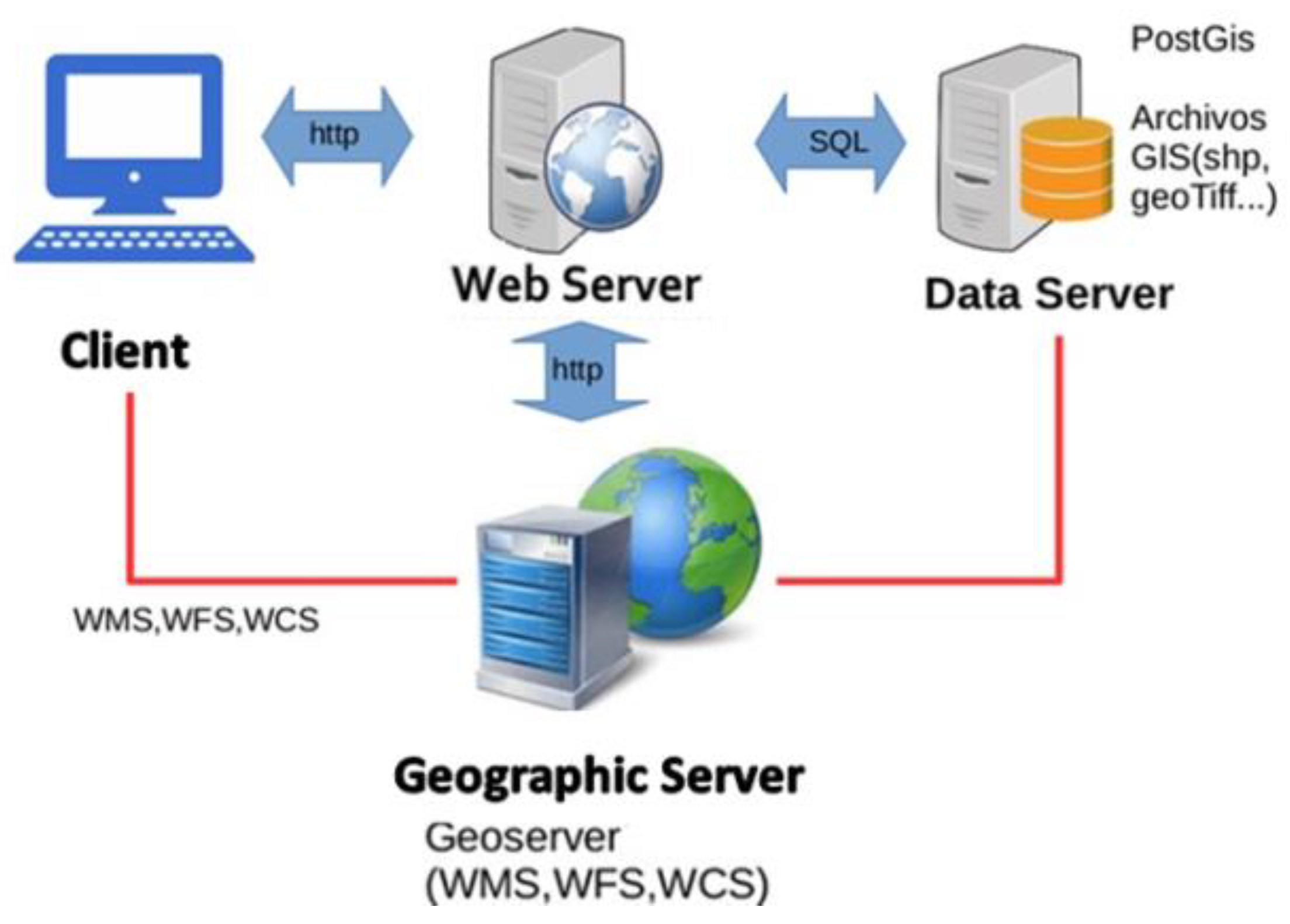

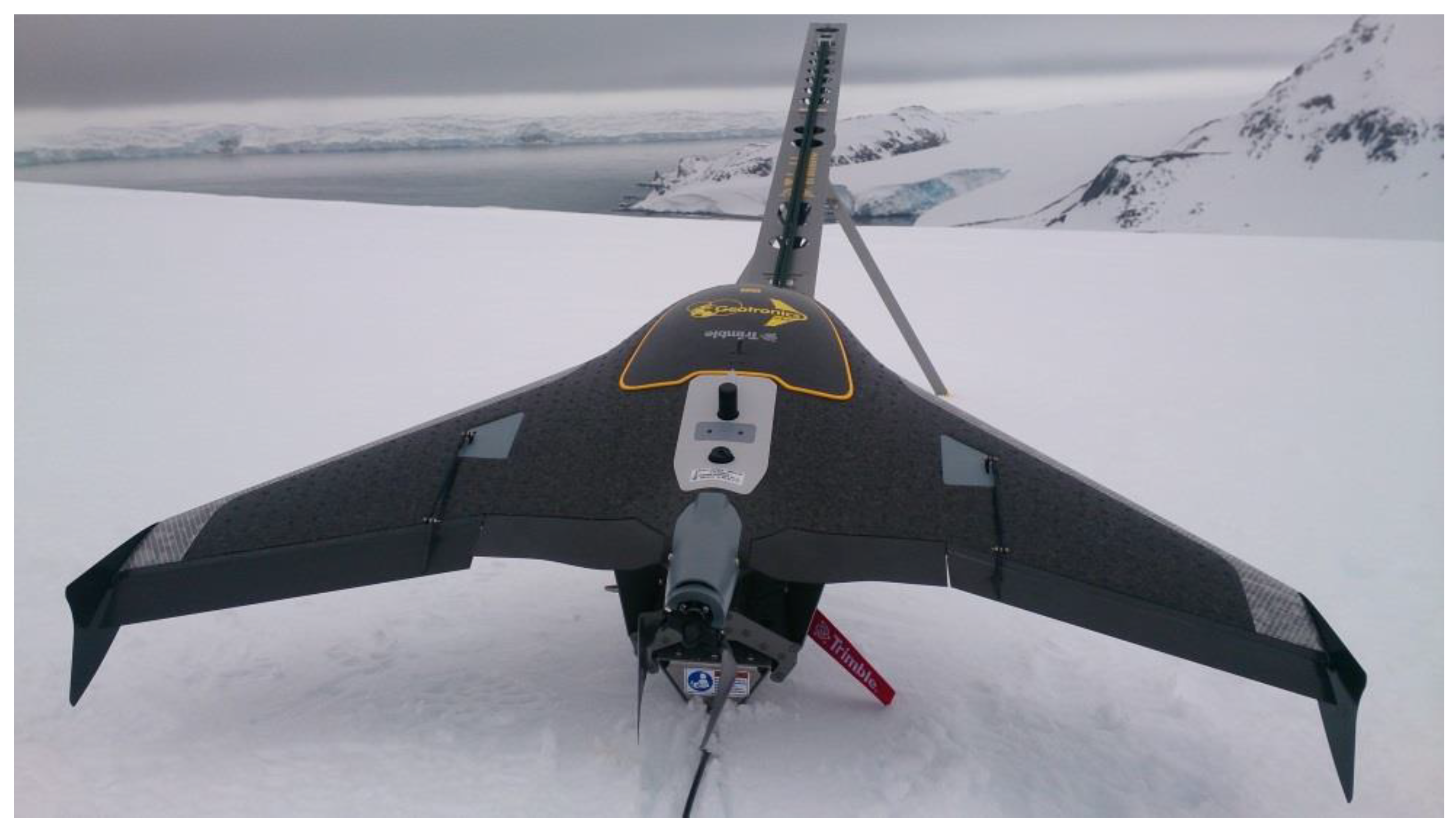
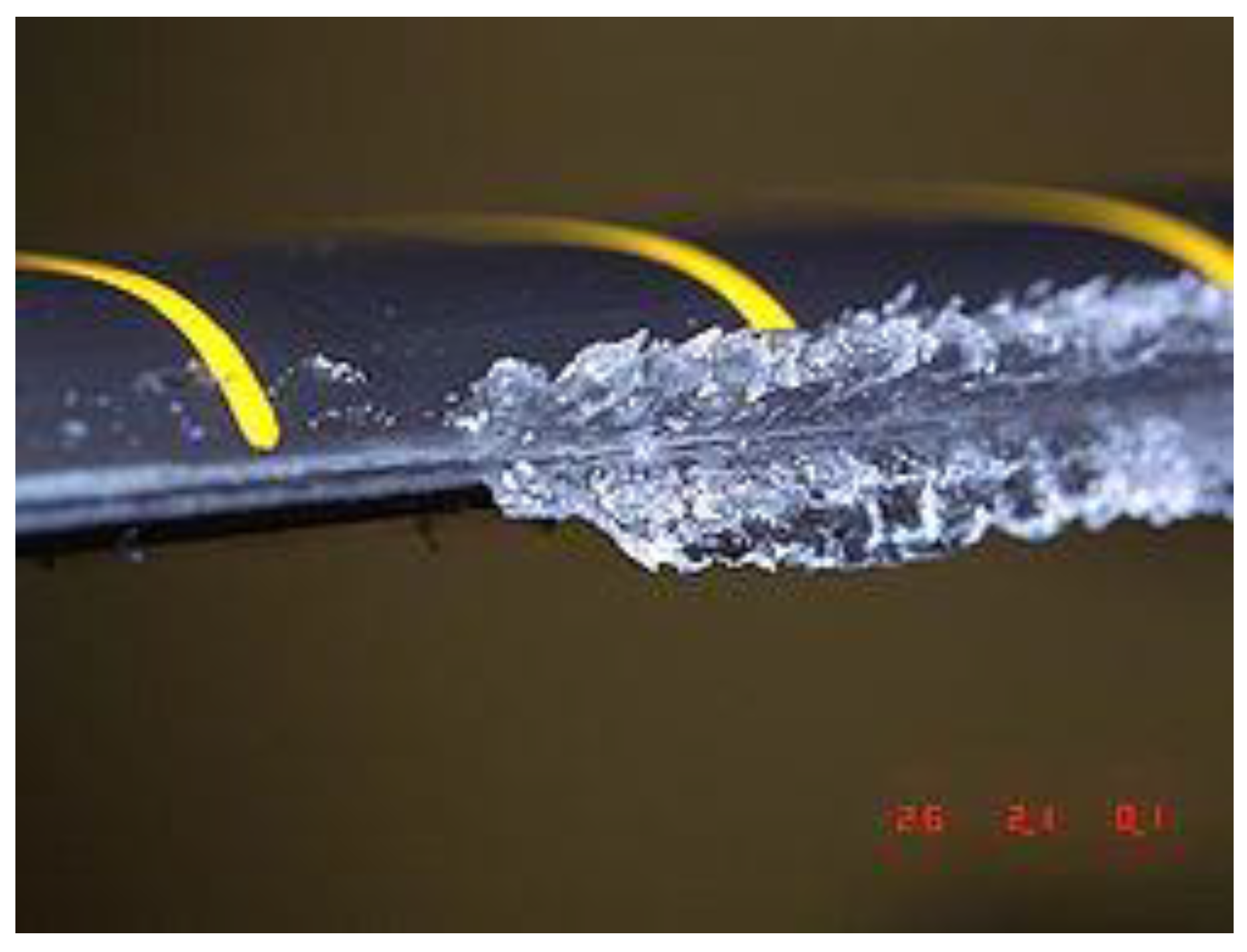
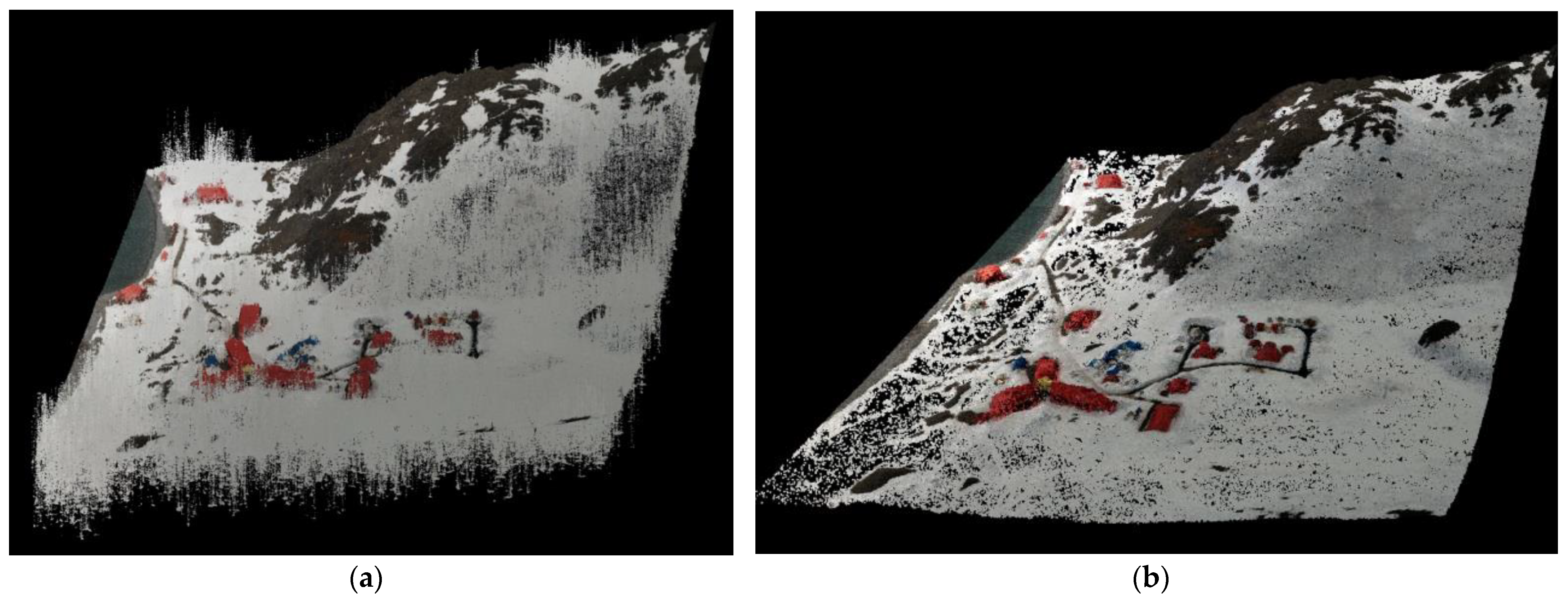

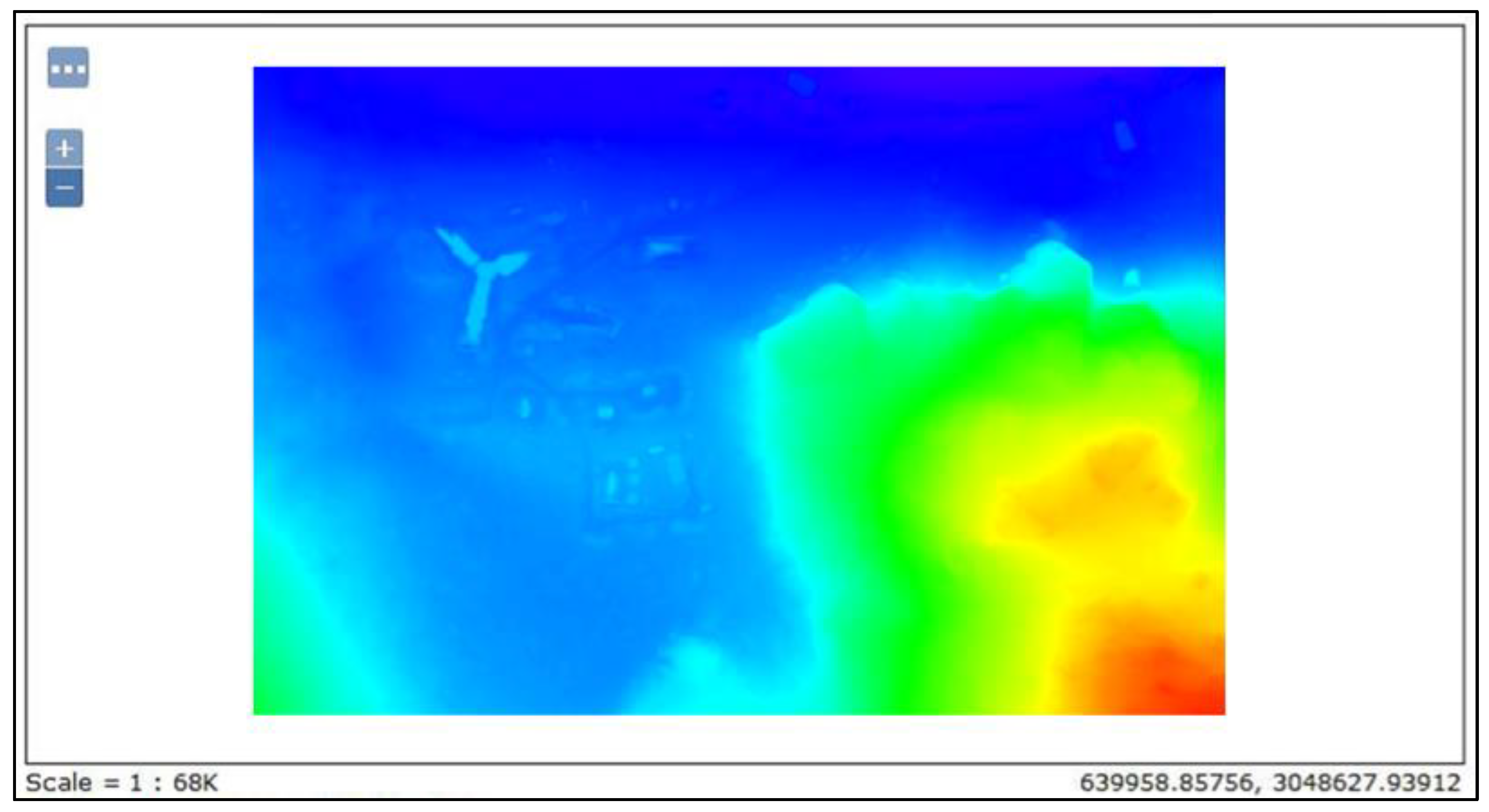
| Summer Statistics | BAE JCI | Johnsons |
|---|---|---|
| Mean temperature (°C) | 1.9 | 0.2 |
| Max temperature (°C) | 15.5 | 11.0 |
| Min temperature (°C) | −7.0 | −11.6 |
| Relative humidity (%) | 80 | |
| Precipitation (mm) | 148.6 | |
| Mean pressure (hPa) | 987 | |
| Max pressure (hPa) | 1017.6 | |
| Min pressure (hPa) | 898 | |
| Mean wind speed (km/h) | 12 | 16 |
| Max wind speed (km/h) | 138 | 134 |
| Technical Specifications | |
| Weight | 2.5 kg (5.51 lb) |
| Dimensions | 100 cm × 65 cm × 10.5 cm (39.37 in × 25.59 in × 4.13 in) |
| Material | EPP foam; carbon frame structure; composite elements |
| Propulsion | Electric pusher propeller; brushless 700 W motor |
| Battery | 14.8 V, 6000 mAh |
| Operational Specifications | |
| Endurance | 50 min |
| Range | 60 km (37.28 mi) |
| Cruise speed | 80 km/h (50 mph) |
| Maximum ceiling | 5000 m (16,404 ft) |
| Takeoff Type | Catapult launch |
| Landing Type | Belly landing |
| Weather limit | 65 km/h (40.39 mph) and light rain |
| Communication and control frequency | 2.4 GHz (FHSS) |
| Communication and control range | Up to 5 km (3.10 mi) |
| Condition | Acceptable RANGE |
|---|---|
| Weather limitations | Light rain is acceptable; avoid hail, snow, and heavy showers |
| Head wind (for cruise flight) | Maximum 55 kph (34 mph) |
| Cross wind: | |
| For takeoff/landing | Maximum 30 kph (19 mph) |
| For cruise flight | Maximum 55 kph (34 mph) |
| Gusts (for cruise flight) | Maximum 15 kph (9 mph) |
| Turbulence | Avoid turbulence at all times |
| Temperature: | |
| Rover, including eBox and gBox | −20 to +45 °C (−4 to 113 °F) |
| Camera * | 0 to +30 °C (32 to 86 °F) |
| Battery * | 0 to +30 °C (32 to 86 °F) |
| Launcher * | +10 to 45 °C (50 to 113 °F) |
| Objectives | Techniques and Methods | Software Used |
|---|---|---|
| Adaptation of aerial photogrammetry using drones to Antarctic weather conditions |
| |
| Generation of DSM of glaciers and derived cartography |
|
|
| Web publication of results as a prototype of Antarctic SDI |
|
| Flight ID | Date (yymmdd) | Location | Flight Time (hh:mm) | Flight Duration (hh:mm) | Flight Height (m) | GPS Nr. Satellites | Weather Type | Temp (°C) | Wind Speed (kt) | Wind Direction | Camera Configuration | Nr. Photos | GSD (cm) |
|---|---|---|---|---|---|---|---|---|---|---|---|---|---|
| 1 | 141204 | Johnsons Glacier | 0:12 | 300 | 10 | fog | [−4, −3] | (S) 5.6|1/2000|ISO AUTO | 104 | 9.6 | |||
| 2 | 141204 | Johnsons Glacier& Johnsons Peak | 0:05 | 10 | fog | [−4, −3] | Internal Video | - | - | ||||
| 3 | 141206 | Glacier (Mac Gregor) | 0:33 | 210 | 11 | sunny | [−4, −3] | NNE | (S) 5.6|1/2000|ISO AUTO | 140 | 6.7 | ||
| 4 | 141206 | Sally Rocks Glacier (Up) | 0:01 | 250 | 11 | sunny | [−4, −3] | (S) 5.6|1/2000|ISO AUTO | - | 6.7 | |||
| 5 | 141206 | Hurd Glacier (test2) | 13:01 | 0:40 | 100 | 11 | sunny | [−4, −3] | (S) 5.6|1/2000|ISO AUTO | 834 | 3.2 | ||
| 6 | 141209 | Johnsons Glacier&Flight1 | 14:30 | 0:40 | 150 | 11 | cloudy | [−4, −3] | 15–20 | SW | (A) 9|1/4000|ISO 100 | 160 | 4.8 |
| 7 | 141209 | Johnsons Glacier&Flight2_Video | 16:17 | 0:30 | 150 | 11 | cloudy | [−4, −3] | 15–20 | SW | Internal Video | - | - |
| 8 | 141209 | Johnsons Glacier&Flight3 | 16:47 | 0:35 | 75 | 11 | cloudy | [−4, −3] | 15–20 | SW | (A) 9|1/4000|ISO 100 | 67 | 2.4 |
| 9 | 141213 | Johnsons Glacier & Bay(RGB) | 11:00 | 0:01 | 260 | 11 | overcast | [0, 1] | 0–5 | SSE | (S) 5.6|1/4000|ISO 100 | - | 8.0 |
| 10 | 141213 | Johnsons Glacier_Cross Bay | 11:15 | 0:32 | 260 | 12 | overcast | [0, 1] | 0–5 | SSE | (S) 5.6|1/4000|ISO 100 | 458 | 8.0 |
| 11 | 141213 | Johnsons Glacier_Sofia Peak (RGB) | 12:00 | 0:32 | 260 | 12 | overcast | [0, 1] | 0–5 | SSE | (S) 5.6|1/4000|ISO 100 | 204 | 8.0 |
| 12 | 141213 | Johnsons Glacier_Sofia Peak (RGNir) | 0:01 | 260 | 12 | overcast | [0, 1] | 0–5 | SSE | (S) 5.6|1/4000|ISO AUTO | - | - | |
| 13 | 141216 | Hurd Glacier | 0:02 | 150 | 12 | sunny | [0, 1] | 0–5 | SSE | (S) 4.5|1/4000|ISO AUTO | 234 | 4.8 | |
| 14 | 141219 | BAE Juan Carlos I (BAE JCI) | 16:45 | 0:15 | 75 | 11 | cloudy | [0, 1] | 05–10 | NE | (S) 4.5|1/4000|ISO AUTO | 23 | 2.4 |
| 15 | 141220 | Johnsons Glacier (Diff. Heights) | 11:08 | 0:05 | 150 | 12 | cloudy | [0, 1] | 05–10 | NE | (S) 4.5|1/4000|ISO AUTO | - | 4.8 |
| 16 | 141220 | Johnsons Glacier (Diff. Heights_2) | 11:35 | 0:05 | 150 | 12 | cloudy | [0, 1] | 05–10 | NE | (S) 4.5|1/4000|ISO AUTO | - | 4.8 |
| 17 | 141220 | Johnsons Glacier (Diff. Heights_3) | 12:03 | 0:21 | 150 | 12 | cloudy | [0, 1] | 05–10 | NE | (S) 4.5|1/4000|ISO AUTO | 214 | 4.8 |
| 18 | 141220 | Johnsons Glacier (Diff. Heights_4) | 12:54 | 0:17 | 260 | 12 | cloudy | [0, 1] | 05–10 | NE | (S) 4.5|1/4000|ISO AUTO | 104 | 4.8 |
| 19 | 141220 | Johnsons Glacier_Cross Bay_2 | 13:54 | 0:38 | 260 | 11 | cloudy | [0, 1] | 05–10 | NE | (S) 4.5|1/4000|ISO AUTO | 512 | 4.8 |
| 20 | 141220 | Johnsons Glacier (RGNir) | 14:40 | 0:21 | 260 | 9 | cloudy | [0, 1] | 05–10 | NE | (S) 4.5|1/4000|ISO AUTO | 104 | - |
| Date (dd/mm/yyyy) | 2 December 2014 | 3 December 2014 | 4 December 2014 | 5 December 2014 | 6 December 2014 | 7 December 2014 | 8 December 2014 | 9 December 2014 | 10 December 2014 | |
| Cloud cover | overcast | cloudless | fog | overcast | sunny | cloudy | cloudy | cloudy | cloudy | |
| Rainfall/Snowfall | yes | no | no | yes | no | yes | yes | no | yes | |
| Wind (km/h) | 20 | 28 | 10 | 35 | 25 | 15 | 20 | 35 | 40 | |
| Gust (km/h) | 45 | 38 | 25 | 45 | 35 | 25 | 25 | 65 | 100 | |
| Date (dd/mm/yyyy) | 11 December 2014 | 12 December 2014 | 13 December 2014 | 14 December 2014 | 15 December 2014 | 16 December 2014 | 17 December 2014 | 18 December 2014 | 19 December 2014 | 20 December 2014 |
| Cloud cover | cloudy | cloudless | cloudless | cloudy | cloudy | sunny | cloudy | cloudy | cloudy | cloudy |
| Rainfall/Snowfall | yes | no | no | yes | yes | no | yes | yes | no | no |
| Wind (km/h) | 40 | 30 | 10 | 25 | 25 | 35 | 30 | 40 | 20 | 20 |
| Gust (km/h) | 65 | 55 | 25 | 35 | 35 | 45 | 45 | 55 | 25 | 25 |
| Battery Level 100% | Battery Level Reduced 30% | ||||||
|---|---|---|---|---|---|---|---|
| Height | GSD (cm) | Coverage (km2) | Flight Lines | Height | GSD (cm) | Coverage (km2) | Flight Lines |
| 75 | 2 | 0.76 | 40 | 75 | 2 | 0.53 | 28 |
| 100 | 2.6 | 1.20 | 30 | 100 | 2.6 | 0.84 | 21 |
| 150 | 3.9 | 2.07 | 20 | 150 | 3.9 | 1.45 | 14 |
| 250 | 6.5 | 3.84 | 12 | 250 | 6.5 | 2.69 | 8 |
| 300 | 7.8 | 4.70 | 10 | 300 | 7.8 | 3.29 | 7 |
| Name | Y UTM (m) | X UTM (m) | Z GPS (m) | Z model (m) | Difference (m) |
|---|---|---|---|---|---|
| baejci_CGP01 | 3049294.639 | 633869.907 | 27.407 | 27.426 | 0.019 |
| baejci_CGP02 | 3049295.409 | 633869.229 | 27.402 | 27.548 | 0.146 |
| baejci_CGP03 | 3049296.854 | 633867.867 | 27.400 | 27.565 | 0.165 |
| baejci_CGP04 | 3049294.801 | 633865.695 | 27.399 | 27.533 | 0.134 |
| baejci_CGP05 | 3049361.754 | 633995.773 | 24.007 | 24.484 | 0.477 |
| baejci_CGP06 | 3049344.414 | 633966.083 | 24.640 | 24.786 | 0.146 |
| baejci_CGP07 | 3049344.271 | 633965.967 | 24.630 | 24.731 | 0.101 |
| baejci_CGP08 | 3049353.455 | 633943.808 | 23.764 | 23.849 | 0.085 |
| baejci_CGP09 | 3049352.922 | 633943.953 | 23.749 | 23.622 | -0.127 |
| baejci_CGP10 | 3049353.127 | 633944.669 | 23.751 | 23.633 | -0.118 |
| baejci_CGP12 | 3049341.692 | 633880.631 | 21.993 | 22.281 | 0.288 |
Publisher’s Note: MDPI stays neutral with regard to jurisdictional claims in published maps and institutional affiliations. |
© 2022 by the authors. Licensee MDPI, Basel, Switzerland. This article is an open access article distributed under the terms and conditions of the Creative Commons Attribution (CC BY) license (https://creativecommons.org/licenses/by/4.0/).
Share and Cite
Bello, A.B.; Navarro, F.; Raposo, J.; Miranda, M.; Zazo, A.; Álvarez, M. Fixed-Wing UAV Flight Operation under Harsh Weather Conditions: A Case Study in Livingston Island Glaciers, Antarctica. Drones 2022, 6, 384. https://doi.org/10.3390/drones6120384
Bello AB, Navarro F, Raposo J, Miranda M, Zazo A, Álvarez M. Fixed-Wing UAV Flight Operation under Harsh Weather Conditions: A Case Study in Livingston Island Glaciers, Antarctica. Drones. 2022; 6(12):384. https://doi.org/10.3390/drones6120384
Chicago/Turabian StyleBello, Ana Belén, Francisco Navarro, Javier Raposo, Mónica Miranda, Arturo Zazo, and Marina Álvarez. 2022. "Fixed-Wing UAV Flight Operation under Harsh Weather Conditions: A Case Study in Livingston Island Glaciers, Antarctica" Drones 6, no. 12: 384. https://doi.org/10.3390/drones6120384
APA StyleBello, A. B., Navarro, F., Raposo, J., Miranda, M., Zazo, A., & Álvarez, M. (2022). Fixed-Wing UAV Flight Operation under Harsh Weather Conditions: A Case Study in Livingston Island Glaciers, Antarctica. Drones, 6(12), 384. https://doi.org/10.3390/drones6120384






